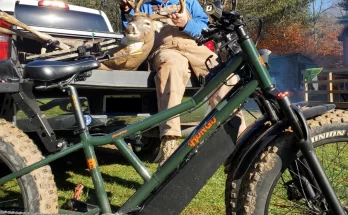As hunters increasingly turn to the efficiency and versatility of electric bikes (eBikes) for navigating the rugged landscapes of their pursuits, understanding the intricacies of eBike battery costs becomes paramount. The battery is the lifeblood of an electric bike, dictating its range, performance, and overall reliability.
For those venturing into the wild, where the call of the hunt meets the need for eco-friendly mobility, assessing eBike battery costs is more than a financial consideration—it’s a strategic investment in the seamless fusion of technology and the great outdoors. In this exploration, we delve into the factors influencing eBike battery costs, deciphering the intricacies to guide hunters in making informed decisions for an electrifying and sustainable journey through the untamed wilderness.
What’s the eBike Battery Cost for Hunters?

The eBike battery cost for hunters is a critical factor in determining the feasibility and efficiency of integrating electric bikes into their hunting expeditions. The price of eBike batteries can vary significantly based on several key factors.
First and foremost is the battery type. Lithium-ion batteries, popular for their energy density and lightweight nature, are commonly used in eBikes. However, variations in lithium-ion technologies, such as lithium-cobalt, lithium-nickel-manganese-cobalt oxide (NMC), and lithium-iron-phosphate (LiFePO4), can influence costs. Generally, higher-capacity and technologically advanced lithium-ion batteries tend to be more expensive.
The capacity of the battery, measured in watt-hours (Wh), directly impacts the range an eBike can cover on a single charge. Higher-capacity batteries come with higher price tags but offer extended ranges, a crucial consideration for hunters covering vast terrains.
Moreover, brand reputation and quality play a significant role in eBike battery costs. Established and reputable brands often invest in advanced battery technologies, ensuring reliability and longevity. However, this quality often comes at a premium.
Considering these factors, eBike battery costs for hunters can range from a few hundred to over a thousand dollars. While the upfront investment may seem substantial, it’s essential to view it as a strategic investment in a key component that profoundly influences the overall performance and convenience of electric bikes during hunting escapades. Hunters must weigh these factors against their specific needs and budget constraints to select an eBike battery that aligns with their hunting requirements.
How to Take Care of the Electric Bike’s Battery?

Caring for an electric bike’s battery is crucial to ensure longevity, sustained performance, and an optimal riding experience. Consider charging your battery after each ride, avoiding deep discharges. Always use the charger provided by the manufacturer to ensure compatibility, and be cautious of overcharging as it can impact the battery’s lifespan.
When storing your electric bike and battery, choose a cool, dry place away from extreme temperatures. If storing for an extended period, ensure the battery has a partial charge, approximately 50%, to prevent deep discharge.
Regularly inspect the battery for any physical damage or signs of wear, addressing any issues promptly. Confirm that the battery connectors are clean and securely attached.
Opt for smooth and steady rides, minimizing sudden accelerations and decelerations to create optimal riding conditions. If your eBike has multiple batteries, rotate their usage to ensure balanced charging and discharging.
Follow the manufacturer’s recommended maintenance schedule for your electric bike, and regularly check and adjust tire pressure to reduce resistance and enhance overall efficiency.
Refrain from fully depleting the battery regularly; partial discharges are preferable for lithium-ion batteries. When cleaning the eBike and battery, use a soft, damp cloth, and avoid direct water exposure to electronic components. Adopting these practices will help riders maximize the lifespan of their electric bike’s battery, ensuring it remains a reliable power source for countless journeys through various terrains.
How to Extend the eBike’s Battery Range

Efficient riding habits involve opting for pedal-assist modes when appropriate to reduce reliance on the motor and maintaining a consistent and moderate speed while avoiding sudden accelerations and decelerations. Terrain management includes strategically choosing routes with varying terrain, utilizing downhill slopes for regenerative braking, and minimizing the use of motor power on flat or downhill stretches.
Appropriate gear usage is crucial, requiring the use of the right gear for different terrains to reduce strain on the motor and shifting gears smoothly to optimize the energy efficiency of the eBike. When it comes to tire maintenance, keeping tires properly inflated to the recommended pressure reduces rolling resistance, and opting for tires with lower resistance enhances efficiency.
Effective battery management involves charging the battery when it reaches around 20-30% capacity rather than waiting for a complete discharge and storing the eBike and battery in a cool, dry place to prevent overheating. Weight consideration plays a role in traveling light by carrying only essential gear to reduce the load on the motor and distributing weight evenly for better balance and efficiency.
Lastly, moderate motor use is advised, with riders using the motor judiciously, especially in situations where pedal power alone can suffice, and adjusting the power settings based on the terrain and riding needs. Incorporating these practices into your eBike riding routine can significantly extend the battery range, allowing for longer and more enjoyable journeys through diverse landscapes and contributing to a more sustainable and eco-friendly riding experience.
Conclusion
Understanding the landscape of eBike battery costs is crucial for hunters seeking a seamless blend of technology and tradition in their pursuits. The battery serves as the heartbeat of the electric bike, influencing its range, performance, and overall reliability. While costs may vary based on factors such as battery type, capacity, and brand reputation, hunters must view this investment as a strategic one—an essential component that dictates the success and efficiency of their electric bike in the rugged terrains of hunting grounds.
Choosing the right eBike battery involves a delicate balance between budget considerations and the specific needs of the hunting expedition. Prioritizing quality, compatibility, and the longevity of the battery ensures a reliable companion for countless journeys through the untamed wilderness. As technology continues to evolve and the market expands, staying informed about eBike battery costs empowers hunters to make decisions that align with both their financial constraints and the demands of their hunting adventures. The intersection of eco-friendly mobility and the pursuit of the wild becomes not just a thrilling exploration but a thoughtful investment in a sustainable and exhilarating hunting experience.




